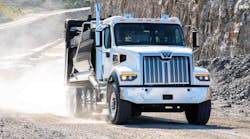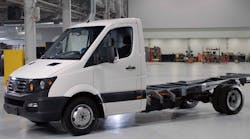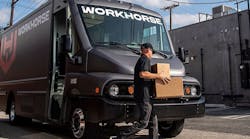With the diesel-price plunge and a love affair with natural gas to power commercial trucks, does the hybrid truck still have a place in the future of transportation? Glenn Ellis, vice president of marketing, dealer operations and product planning for Hino Trucks, says yes.
Ellis gave a presentation on the cabover market, particularly hybrid models in Hino’s lineup, during the recent Green Truck Summit in Indianapolis, held in conjunction with the NTEA’s Work Truck Show.
“Over the last year and one-half, there has been a lot of regulatory activity and a lot of additional cities and states looking to get more hybrids into their [communities],” he said. “There’s still a tremendous environmental benefit. If you are getting 15 to 30% fuel savings, you are also getting a 15 to 30% environmental savings.”
Ellis mentioned a few of the states offering incentives to adopt hybrid trucks. They are:
- California. Customers can receive an $18,000 voucher towards the purchase price of eligible vehicles plus a $5,000 bonus for the first three vehicles
- New York. The state is offering $14,400 towards eligible vehicles that will be operating within the NYC’s five boroughs
- Chicago. The city has just launched its Drive Clean Chicago program, awarding $14,400 per vehicle
- Maryland. The state is now offering a $12,000 voucher through its Freedom Fleet Voucher program
According to Ellis, the upcharge for a Hino hybrid is $12,000, so adding the vouchers plus the fuel savings is truly a winning preposition for fleets, he said.
“This year we’ve seen strong demand in the New York area as well as California,” he said. “We’ve seen, in a multitude of applications, customers really taking advantage [of the benefits of hybrids].”
Ellis said that Hino sold 451 hybrid trucks in 2013 and 355 in 2014. In 2015, the company has sold 43, but that number should rise as fuel prices climb. Worldwide, Hino has sold 15,000 hybrid units since their launch.
Hino offers the 195H and 195H-DC (double cab) in its hybrid lineup. The Class 5 vehicles feature a 19,500 GVW and a 210 hp diesel engine producing 440 lbs.-ft. of torque mated to a A464 Aisin 6At transmission. An important note about Hino’s hybrid system, Ellis pointed out, is that the system uses common components, meaning there is cost effectiveness. Sixty percent of the components are shared with Toyota’s hybrid system used on its Prius.
“This product isn’t for everybody,” Ellis said. “It is a product that is targeted for specific routes.”
Those routes include urban areas where the vehicle will have a low average speed of 17-25 mph with 22 mph the most efficient speed. The vehicle also will make multiple stops in a day and feature plenty of stop-and-go driving so the regenerative braking system can generate enough energy to charge the battery. It also will spend less than 20% of its time driving highway miles.
Hino hybrids also feature Insight 2.0 powered by Telogis, a telematics program that is offered on all hybrids free for one year. Insight provides data to help fleet managers manage their vehicles and driver’s driving habits.
“Insight is a tremendous tool to provide data back to the owner on how their vehicles are performing in the marketplace,” Ellis said. “Insight provides benchmarking versus your own fleet and like fleets.”
And that, Ellis noted, really tips the hybrid equation in the favor of fleets.








